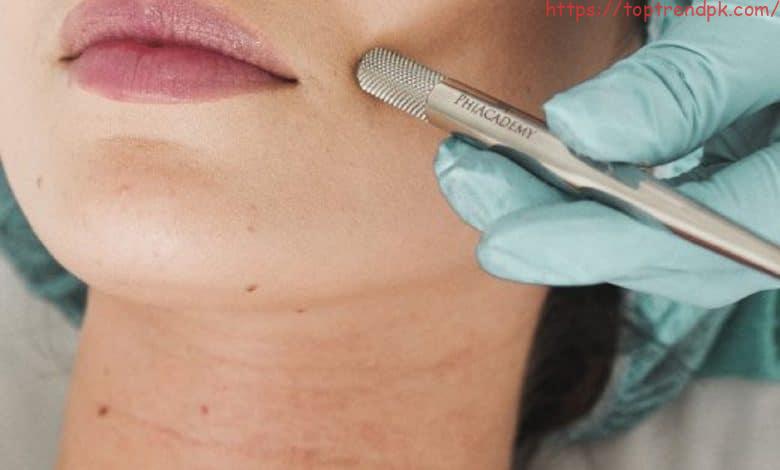Easy way how to remove dark patches on skin [12 Easy Tips]

Many adults suffer from melasma, a form of hyperpigmentation in which skin areas become darker than their surroundings. These stubborn dark spots that can be found anywhere on the face (forehead, cheeks, nose, etc.) are caused by the overproduction of melanin from pigment cells called dark patches on the skin.
How to remove scratches from phone screen: That’s Really Works]
Reason of dark patches on skin and black spots on face
Although melasma does not affect your overall health, its characteristic dark patches on the skin can often look unsightly, causing those suffering from this disorder.
Read on to learn about effective ways to eliminate these stains and make them less visible.
Learn about the best and most advanced treatment methods and choose one of the many methods for correcting uneven skin tone. This article will also tell you about the causes of melasma and dark patches on the skin so you can prevent it from developing.

What is melasma?
There are several possible causes of skin hyperpigmentation, some of which can be pretty serious. As a precaution, it is best to consult a dermatologist for dark patches on the skin if you notice any skin discoloration at an early stage to exclude precancerous changes and skin cancer.
However, one of the most common forms of hyperpigmentation is melasma, characterized by unsightly dark spots on the face and liver spots, forehead cheeks, and the area above the upper lip.
These spots usually appear on both sides of the face in a similar shape and pattern and vary from brown to dark brown or black. The color of the sites varies depending on the ethnicity of the person. For example, for black people, the color will be more towards brown and black spots.
In pale individuals, they may appear brown or light brown. Stains on the skin can occur in both men and women people of all ages and skin tones.
Depending on the underlying cause. Similarly, “spots on the liver,” another common term for hyperpigmentation, usually develops in people 50 years of age or older throughout life in the sun and are considered part of the natural aging process.
The good news is that these frustrating flaws can be easily eliminated and reduced. Choose from medical procedures to completely natural self-cooking products that you can use without leaving your home. Dark patches on the skin As always, developing the proper skin care regimen and using methods to prevent sun damage is the best way to deal with unsightly sunspots.
Common types of hyper pigmentation
| condition | Appearance | causes |
| melanoderma | Pale brown, brown, or dark spots and spots on the face | Hormones, pregnancy, and sun |
| Liver Stains (Solar Lentigo) and Age Spots | Small brown or dark spots on the face, arms, shoulders, and arms | Age (50+), sun and pale skin |
| Moles | Irregular red or brown spots that appear at birth or shortly after | Additional pigment cells or blood vessels |
| Moles | First, appear in adolescents or adulthood; pink, light brown, black, raised; right or wrong shape. | The development of skin lesions in adulthood; often benign but sometimes malignant |
| Freckles | Small brown spots, varying in color and often with a pattern | UV radiation / exposure and genetics |
10 home remedies to remove dark patches on skin
Even the most aggressive treatment options may take some time to work for dark patches on the skin. Meanwhile, there are many things you can do to minimize the appearance of dark spots and make them less noticeable. For example, if you have sensitive skin and want to avoid irritation or work with an acne-prone skin type, you can choose serums moisturizers.
And creams as well as more aggressive treatments like stain removers whitening products and medical treatments. As a bonus, many of these natural remedies reduce melanin production and contribute to the renewal of skin cells and reduce wrinkles moisturize dry skin.
Reduce fine lines and improve overall skin condition about dark patches on the skin. You might want to try some of these home remedies first, especially if you notice a color change in the initial stages. Before attempting to use any of the methods recommended below, consult with a qualified specialist since the needs of each person in medical care will vary.This is especially true for pregnant or breastfeeding women, those currently taking medication, and people with sensitive skin.
1. Exfoliation
If the dark spots are new, they can only cover the first few layers of the skin. In this case, dark patches on skin manually exfoliating the area may be the solution. Here’s how:

1.Find the exfoliating cleanser of your choice and apply it to the area in a circular motion. Depending on your product, you may wet your face before you start.
2.Massage the product into the skin and rinse. Exfoliate once a day or every other day until you can analyze how your skin handles the procedure. After that, repeat once or twice a day for best results.
2. Citrus rub
Citrus fruits contain a significant amount of ascorbic acid, which can remove the top layer of the skin without damage.
( Note) Before testing, consider testing lemon juice on a small piece of skin.) Here’s how to make citrus rubbing:

1. Squeeze lemon juice on a cotton swab.
2. Apply it on the skin and leave for 20 minutes.
3. Repeat once or twice a day for best results.
DIY honey and lemon face mask
Another alternative would be to make a face mask with honey and lemon:
1. Mix the juice of half a lemon with two teaspoons of honey.
2. Apply to the affected area for 30 minutes and then wash thoroughly.
DIY Lemon-Turmeric Brightening Paste
Another option is to make a paste of lemon juice with turmeric, which is also a means to lighten the skin:
1. Add one tablespoon of lemon juice to one tablespoon of turmeric.
2. Apply the paste on the face for 15 minutes.
3. Wash with warm water.
3. Vitamin E.

Vitamin E is a powerful antioxidant and can help your body repair damaged cells. You can apply vitamin E oil directly to your skin and eat foods high in vitamin E, such as nut avocado, leafy greens, tofu, and dark pumpkin patches on the skin. Vitamin E capsules and serums are sold in most major markets and are reasonably affordable.
4. Papaya
Papaya contains papain, an enzyme that helps exfoliate the skin. Papaya also contains many vitamins C and E, which makes this fruit ideal for reducing discoloration.
Here are two ways for dark patches on the skin to use this superfood:

1.Try to apply a small fetus piece to the affected area twice a day for 20-30 minutes.
2.Mix papaya in mask paste and apply for 30 minutes.
5. Folic acid
Several studies have linked melasma to a folic acid deficiency, such as vitamin B, and obstetrics often prescribes obstetrics to pregnant women with melasma for dark patches on the skin.

Therefore, it is highly recommended that you take supplements and eat foods that contain a lot of this crucial nutrient, as advised by your doctor. High folate foods include leafy green vegetables, citrus fruits, beans, and whole grains.
6. Licorice root
Licorice root has been widely used in folk medicine for hundreds of years. Dark patches on skin It contains glabridin and Lycochalcon A, two powerful antioxidants:

1.Glabridin can help reduce the damage from the sun and inhibits the synthesis of melanin, which contributes to the development of sunspots after exposure to ultraviolet radiation.
2.Lycochalcon A also helps fight free radicals and inflammation, beneficial for people with eczema and rosacea.
Consider taking licorice root as tea or incorporating it into your diet, as it is perfect for hyperpigmentation and acne scars.
7. Aloe
Aloe vera has been proven to help reduce dark spots and hyperpigmentation thanks to aloin, a composition that naturally depigments the skin.

According to dermatologist and laser surgeon Dr. Deepali Bhardwaj, aloe is rich in vitamin C E and beta carotene. It is incredibly gentle and can be used in a gel or collected directly from the plant and applied to the skin for dark patches. When buying a product, be sure to avoid anything that contains chemical additives.
8. Honey
Honey naturally contains alpha-hydroxy acids, which help exfoliate the skin, and hydrogen peroxide, a natural antimicrobial. In addition, according to Peter Molan of the Honey Research Unit at the University of Waikato, New Zealand, honey reduces stains on acne-prone skin. It thereby helps improve dark patches on the skin.

Honey also helps draw moisture out of the environment to keep skin hydrated. Raw honey is the best form to buy, as processed honey often contains corn syrup and is falsified by additives.
9. Arrutin
Arbutin is found in natural substances such as cranberries, blueberries, and barberry leaves. Once in the body, it breaks down into glucose and hydroquinone, one of the most commonly used skin-lightening components that inhibit melanin production by cells.

Alpha arbutin, which is the preferred form of arbutin, is found in barberry leaves. It is soluble in water, acts on all skin types, and is especially effective when combined with vitamin C. Since synthetic hydroquinone is available only by prescription, consider adding arbutin products to your diet.
10. Hyaluronic acid
Hyaluronic acid (HA) is naturally produced in the skin and is found in all body tissues.
This helps maintain the structure of the tissue – adding thickness to the dermis where collagen is located. In addition, a natural moisturizer (1 gram of HA can hold up to 6 liters of water) absorbs moisture from the environment, which helps increase the level of hydration for all skin types.

When used in combination with vitamin C, these powerful antioxidants help reduce sunspots. HA can be taken orally as a supplement, but it is best used topically if the doctor has not given prior permission. You can also purchase it in your diet in soy, citrus fruits, bone broth, starchy root crops, and leafy greens.
Treatment Options That Can Relieve Melasma
In recent years dark patches on skin treatment have achieved tremendous success. There are many suitable treatments for getting rid of hyperpigmentation.
As always, work with certified/licensed healthcare providers and tell your doctor about your needs before continuing. Below are some of the most popular treatments:

1. Stop hormonal contraception
Since changes in estrogen and progesterone levels usually cause melasma, stopping hormonal birth control pills and IUDs can often be an excellent first step.
Never stop taking contraceptives without first notifying your doctor and or discussing alternatives.
2. Topical whitening creams
The first line of treatment for melasma is topical acid treatment (containing hydroxy acids) designed to remove bleached skin layers.
You can find over-the-counter versions of these procedures as well as more potent prescription drugs.
If you want to purchase an OTC product, find one that contains kojic acid arbutin and lactic acid.
Can pregnant women use skin whitening creams?
If you are pregnant, you can take all the necessary measures to prevent and treat melasma.
However, it would help if you avoided skin whitening creams. Dark patches on skin In most pregnancy-related cases, melasma occurs after childbirth, so it is best to use a concealer.
3. Alpha Hydroxy Acids
Alpha hydroxy acids are naturally occurring acids found in foods such as citrus fruits (citric acid), apples (malic acid), and grapes (tartaric acid).
They work by removing dead skin cells on the upper layer of the skin. According to WebMD, alpha-hydroxy acids are suitable for controlling epidermal and mixed-type melanosis. In addition, those who used 10% glycolic acid for two weeks, followed by facial peels, saw a general decrease in hyperpigmentation.
4. Salicylic acid
Salicylic acid is beta-hydroxy acid or BHA (unlike alpha-hydroxy acid or AHA, in which the molecules are separated by only one carbon atom)
Which comes in the form of prescription strength. It is generally derived from willow bark.AHA (e.g., glycolic and milky) is soluble in water, but BHA is soluble in oil. As a result, BHAs can penetrate deeper into the skin than ANA and dissolve the components of clogged pores. Utilizing the keratolytic process, BHAs effectively eliminate the upper layer of skin cells, thereby offering excellent exfoliating properties.
5. Hydroquinone
Hydroquinone is a very effective skin-lightening agent. However, there are some controversies regarding its safety.
In 2006 the FDA withdrew its approval based on evidence that suggested it could cause cancer.
However, the American Academy of Dermatology disagrees with the FDA.
The group insists that with proper observation, hydroquinone is not a health hazard. 2% strength hydroquinone creams are available over-the-counter, while more concentrated versions require a doctor’s prescription.
6. Retinoids
Retinoids derived from vitamin A increase the rate of skin regeneration. However, retinoid products are available only by prescription due to the potential risk to fetal health in pregnant women.
Retinoids work by causing dead skin cells to recover faster. Keep in mind that these products can also cause skin irritation.
7. Chemical peeling
Chemical peels improve and smooth the skin texture and contain concentrated levels of acids. They work by removing dead cells on the skin’s surface and accelerating regeneration, leading to a smoother and healthier complexion. Made under the supervision of a dermatologist, chemical peeling can successfully get rid of dark spots.
8. Microdermabrasion
Microdermabrasion is a procedure that uses tiny crystals to “sandblast” the upper layers of the skin. This is done by a dermatologist or surgeon who will prescribe local anesthesia—dark patches on the skin. The procedure is usually repeated once a month for several months. Dermabrasion smoothes the skin, which leads to a decrease in wrinkles, pigments, and scars.
9. Intense pulsed light (IPL)
IPL is a laser treatment that uses fast light pulses to kill pigment-causing melanin. The skin repairs the damage caused by the laser leaving a lighter shade after healing dark patches on the skin. This procedure is more expensive than other methods and can sometimes be painful.
10. Steroids
Steroid creams can be applied to the affected areas to treat melasma, slowing down the regeneration process of skin cells, leading to a decrease in the number and activity of pigment-producing cells.
How to prevent melasma
As the old saying goes, an ounce of prevention is worth a pound of cure. In particular, it can be challenging to get rid of melasma. However, when you have it, so prevention is always your best bet. So here are some ways to avoid developing melasma in the first place:

1.Stay away from the sun and tan completely.
2.Always apply sunscreen with an SPF of at least 30, even if you leave home for five minutes to complete errands.
3.Reapply sunscreen every few hours.
4.Wear a wide-brimmed hat and sunglasses to protect your face from the sun.
What causes melasma and brown spots on the skin?
The exact cause of melasma was not identified, although doctors have identified several possible triggers:
Hormonal imbalance: Melasma is more common in women than men and is often associated with hormonal changes. Pregnant women taking hormone replacement therapy or hormone-based contraceptives are susceptible.
In pregnant women, these dark spots are often called the “mask of pregnancy” and usually last until the end of pregnancy.
Exposure to the sun: UV exposure is considered the leading cause of melasma. Some medicines such as anticonvulsants can make the skin more sensitive to the sun increases the risk of developing melasma.
Aromatic soaps and deodorants: some products can irritate the skin, making it more sensitive to the effects of the sun.
Hypothyroidism: Melasma is associated with low levels of thyroid hormones. Check your thyroid hormone levels regularly and work with your doctor to keep your levels within acceptable limits.
Who is predisposed to the development of melasma?
Women: Men make up only a quarter of people diagnosed with melasma.
People with darker skin. People who easily sunbathe or have a higher level of melanin production are more likely to develop melasma.
Those with a family history: one-third of people diagnosed with melasma reported that a family member also suffered from this disease.
What are the different types of melasma?
Not all cases of melasma are the same, and the prognosis of treatment may vary depending on whether it appears on the upper layer of the skin or one of the lower layers.
The following list details various types of melasma that will help you determine what kind you may have (of course, always work with a healthcare professional to make an official diagnosis):
Epidermal
Location: on the outer layer of the skin
Features:
- Clear boundary
- Dark brown spots
- Responds well to treatment
Cutaneous
Background: on the lower layers of the skin
Features:
- The most common type
- Poorly defined boundaries
- Light brown or bluish color
- Poor response to treatment
Mixed
Features:
- Bluish light and dark brown spots
- Moderate improvement in treatment
Think about working with a healthcare professional
Melasma can be caused by many factors and affects people of any age and origin. Natural remedies may be the first way but talk with your healthcare provider or dermatologist for proper advice.
Always work with licensed specialists and consider prevention methods if you see early signs of skin discoloration. As always, an ounce of prevention is worth a pound of cure, so use sun protection as often as possible.




